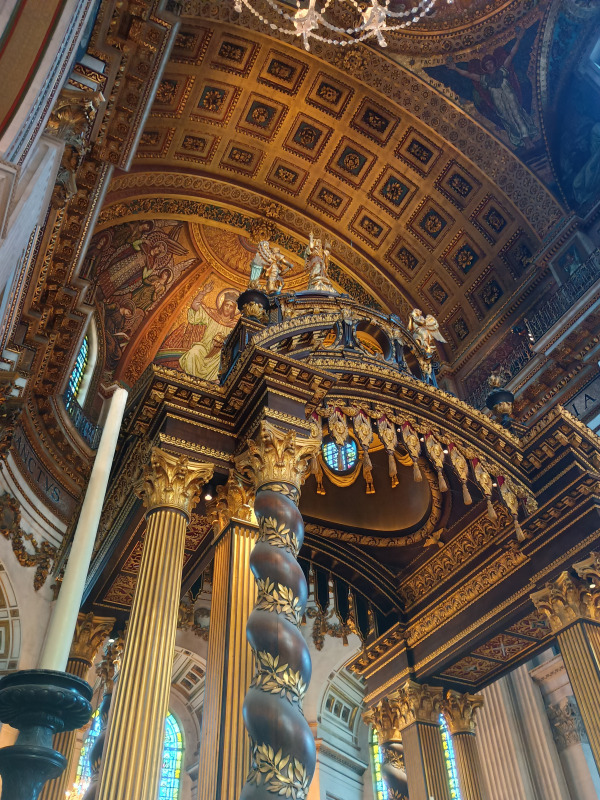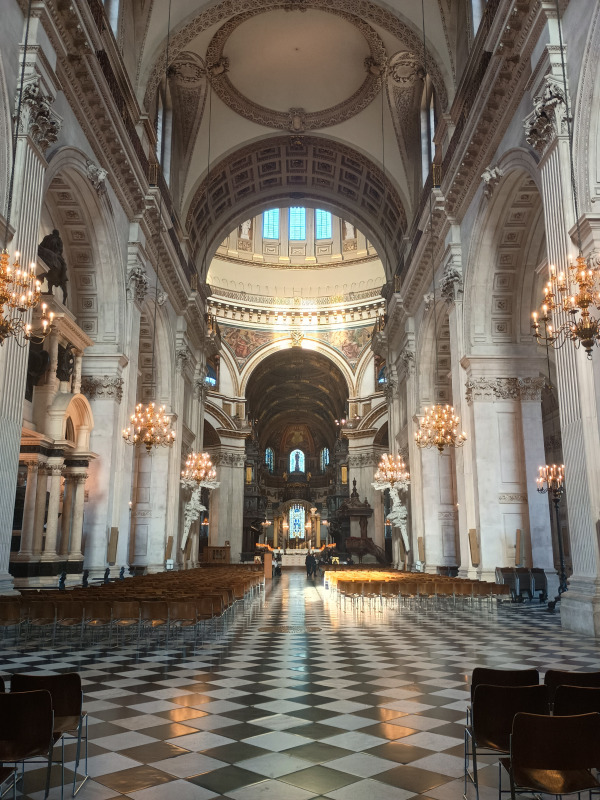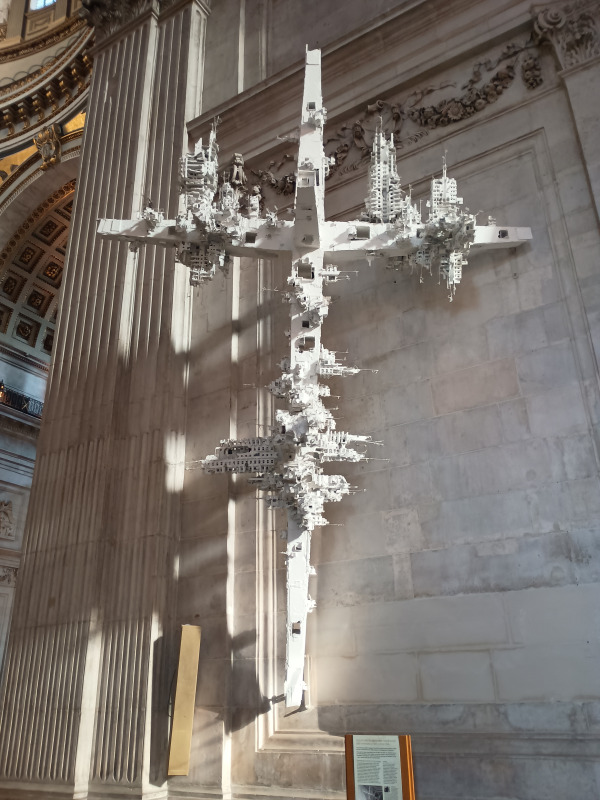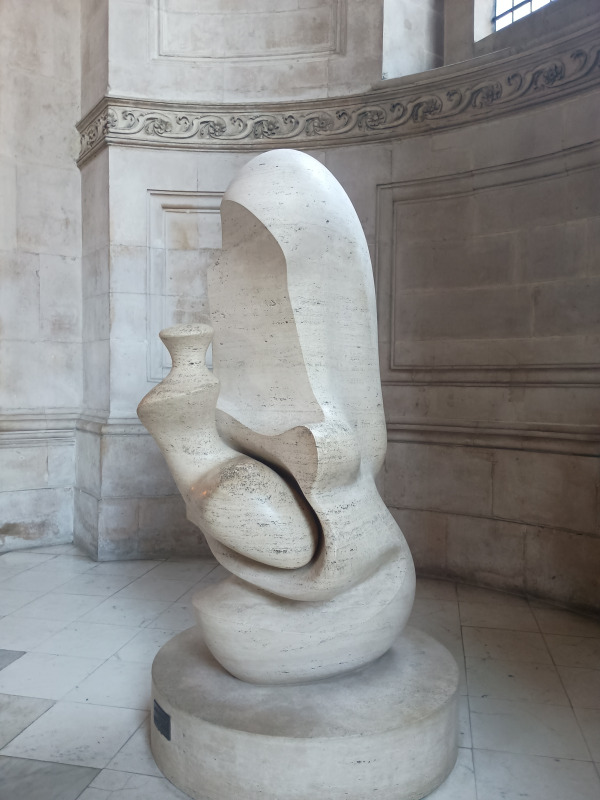
Guess where I am? When I began this project, and started approaching the cathedrals to see if I could perform the Meditation, I didn’t dare hope that 40 out of the 42 would say yes.
St. Paul’s had been very positive at first. That’s a particularly busy day, they said, with wedding rehearsals and other important things, but we might be able to make it work. In the end they couldn’t, because they discovered an inviolable rule, that they weren’t allowed to put on any day-time performances.
So on the pilgrimage I passed by St. Paul’s without going in. It costs a lot to go in.
But some wheels were already in motion. A distinguished Canon of an earlier cathedral had been talking about Pilgrim Cello with a distinguished Canon of St. Paul’s. Why, the latter wanted to know, slightly indignantly, isn’t he playing at St. Paul’s?
So now here I am. It’s more than a month since the last cathedral performance, and the leg muscles are beginning to regain their normal dimensions. I came on the train.
St. Paul’s is having an open evening. Jen, the event manager, who met me at the NW door, is telling me there will be 3,000 people – mostly Londoners who don’t want to pay the normal entry fee. Fair enough, I’m thinking to myself, but not saying out loud.

It’s a terrible thing to say, but I don’t like St. Paul’s. It was England’s biggest cathedral for a couple of centuries, until Liverpool took that crown, and everything about it is just too big, too grand, too regal, too important, too gold, too military, too colonial. And far, far, too Baroque.
Everyone knows that Sir Christopher Wren built it, after the Great Fire of London destroyed an earlier cathedral in 1666. At first he was commissioned just to repair the old one, but eventually he persuaded them that wouldn’t work.
But the ecclesiasticals didn’t like his first design. Nor his second. Not his third either. What we see today is his fourth, or fifth (it depends how you count it) plan. Even that was significantly modified as he went along.
I’m to play in the military chapel, the chapel of St. Michael and St. George. I don’t like that. I’ve never been able to reconcile myself to this aspect of the established Church of England. Somehow it has to say God’s on our side; we prayed for victory, and God gave it to us.

So the cathedral seems to be full of outsized monuments, in marble and alabaster, to military men who spent their lives killing people, but who, in death, can be described as godly, compassionate, and practically saintly. It doesn’t add up. But perhaps that’s just one of my prejudices.
Anyway. Here we are. A 60-strong American choir sang Evensong for a congregation of hundreds, after which the cathedral was efficiently cleared, ready for the evening’s invasion. I’ve done a little bit of practice in the gloomy chapel, and asked if they could find me a light. The invasion begins.
The CFO, whom I met handing out leaflets, tells me that 2,000 people can be accommodated, seated. So 3,000 sounds to me like quite a full cathedral. It will be noisy.
The Meditation is one of two timed events in the evening’s leaflet, and rather more people want to enter the chapel than the 60 it will comfortably hold. And the noise from beyond the open screen requires me to shout, and to play this quiet music fortissimo.
But this is, after all, St. Paul’s, big, grand, regal, important, gold, military, colonial, and Baroque. And I should play my part.
So the Meditation has been performed in 41 of England’s 42 cathedrals. Is that really possible? Or am I just dreaming?


I absolutely agree both about St Paul’s architecturally and the almost canonisation of our war leaders. Don’t get me wrong. Some of the wars we have fought needed to be fought and we needed leaders. But the empire? An embarrassment at best. And mainly much worse.
So how are we going to get you into the 42nd. Remind us all where it is? Come on. Name and shame (again)
I remember that it was Birmingham, which might be one of the smallest Cathedrals. A great shame as my wife and I went to services at Birmingham Cathedral back in the 20 teens. It was very welcoming then. So I don’t understand why it changed and would not accommodate Kenneth. We went to his last one at Carlisle Cathedral, near where we now live. It was well supported there and was as moving as the first time we heard the Meditation at Penrith a couple of years ago.
Like Graham above, I agree about St Paul’s being among the less welcoming of cathedrals. When I was on my 42 pilgrimage it seemed a lot to pay when I could not stop for long, being enroute for Southwell. But when I did go inside another day, I found it glorious in its gold and white finery and the lovely dome.
I hope you get to play in Birmingham sometime… lovely Burne-Jones windows.
I thoroughly enjoyed your book and identified with some of your musical dilemmas ( I’m a double bass player. )I also like cycling but I think travelling with my bass on a bike could be problematic!( unless someone invents a folding one!) do you know the Rossini piece for solo cello and double bass? Well worth a look if you don’t!
Keep cycling and playing!
Well done Mr. Wilson!
Perhaps Birmingham will now not appreciate being the soul outlier.
So how much does it cost to get into St. Paul’s?
I’ve lived in Birmingham for nearly 40 years, and I think I have played in a concert in Birmingham Cathedral once, about 35 years ago. (I’ve played in the Roman Catholic Cathedral round the corner many times, not to mention Lichfield, Coventry and Worcester.) I get the impression that, because they are so small, they have an inferiority complex. So I can understand that you found them more difficult to deal with than St Paul’s, who are so big they can afford to be generous occasionally.